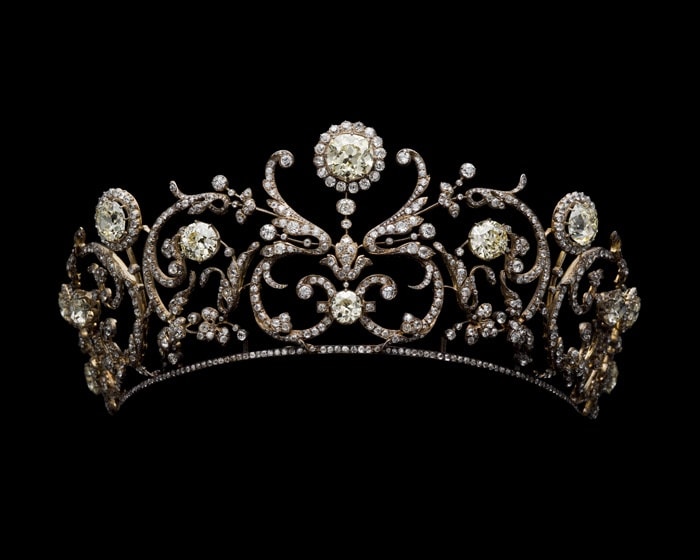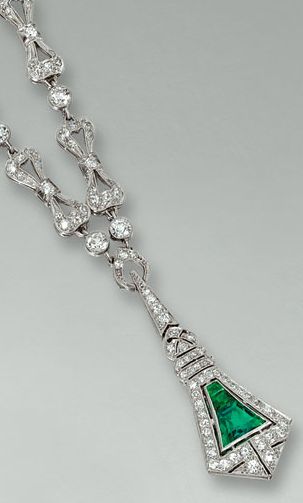
the beginning of the edwardian period
The Edwardian Period, named after King Edward of England, who succeeded Queen Victoria in 1901 often overlaps the Art Nouveau period, which began in France in the 1880s. The turn of the century brought about a lot of unique innovations, such as the telephone and radio, and with it came speculation that things were going to be changing quickly.

Edwardian jewelry started to become less imaginative and more conventional. Detailed enameling and fantasy-inspired designs slowly faded away in favor of garland style swirls and elaborate curves. Jewelry became less colorful, featuring mainly diamonds, and occasionally mixing in less-intense colored stones, such as amethyst and peridot. Some other stones characteristic of the Edwardian period include turquoise, pale blue Montana sapphire, orange Mexican fire opal, Australian black opal, and demantoid garnet paired with small pearls or diamonds.
the edwardian style
The Edwardian style is known for its free-flowing designs and the elegant use of white, whether it be platinum or diamonds. The garland style became a popular design, taking inspiration away from popular architectural and artistic designs of the time. Jewelers for design house Cartier were encouraged to walk the streets of Paris with a notebook to sketch building for inspiration.
platinum replaces silver as the standard white metal for jewelry
Although it had been used for many purposes in the 1700s, it was not until the 1800s that British scientists began experimenting with different alloys of platinum to make it a more suitable option for jewelry.
One of the biggest problems in using platinum to make jewelry is that there was no furnace capable of reaching the temperature required to melt the metal. It was not until 1857 that Henri Ste. Clair Deville created the first furnace capable of melting platinum. These furnaces used mainly pure oxygen to reach such extreme temperatures, and the invention of liquid oxygen in 1895 led to the invention of the oxyacetylene torch, which finally allowed jewelers to melt and cast platinum in their workshops.
Once creating jewelry in platinum became an option, it didn’t take long for it to become the world’s most coveted metal for creating jewelry. The strength of platinum allowed for jewels mounted in white metal to be light-weight and secure; combined with the fact that it does not tarnish, it is no wonder that platinum today is so much more expensive than gold.

a break from white
The Edwardian period is characterized as a break from the imaginative color of the Art Nouveau period, but an event in 1910 brought bright colors back in style all over Europe. This was the first performance in Paris of Scheherazade, a Russian symphonic poem based on the book One Thousand and One Nights, also known as Arabian Nights.
The bright, colorful costumes and scenery captured the attention of the audience and jewelers alike. The liberal use of bright orange, carmine, vermilion, royal blue, emerald green and gold encouraged Parisian jewelers to step out of their shell and once again look to Turkey and the Orient for inspiration. Lotus flowers, cusped arches, peacock feathers and stylized minarets became common motifs, and many top jewelry houses, particularly Cartier, put together a lot of colorful and creative pieces during this time using sapphire, emerald, jade and frosted rock crystal.
the edwardian period comes to an abrupt halt
King Edward died in 1911, but the Edwardian jewelry style lingered on, before ending abruptly following the start of WWI in the late summer of 1914. Germany declared war on France and invaded Belgium on August 3, and Great Britain entered the war the following day. Almost immediately, the free-spirited joyfulness the Edwardian period was known for came to a crashing halt.
Overnight, everything changed in Europe. Jewels and precious metals were sold or hidden away for protection, and many of the famous house jewelers recycled old pieces to make new ones, if they even made jewelry at all. Jewelers across Europe gave up their trade to benefit the war effort, whether that meant making weapons or fighting on the front lines.
For the first time in the history of the world, almost every country in the world was at war with one another. The violence and despair that would ensue would change the mindset of people across the world and would eventually lead to the creative, futuristic style of the Art Deco period.












